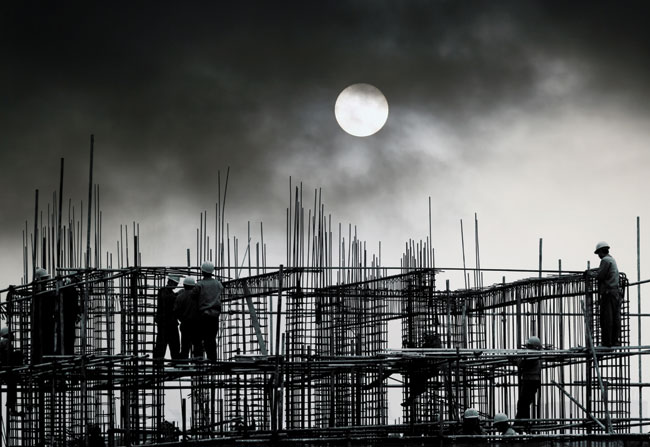The Great Shakeout

The roller coaster ride in the construction industry continues. We expected the 2011 season to be rather flat, but the market continues to hit new peaks and valleys while it slowly chugs along. The industry hit a new milestone in spring. Construction spending fell for the sixth straight month in May, touching an 11-year low, as shrinking public outlays and residential construction swamped a rise in private nonresidential work, according to the Associated General Contractors of America’s (AGC’s) analysis of new Census Bureau data. The construction trade association’s chief economist, Ken Simonson, predicted spending patterns would continue to be uneven.
“Despite a few bright spots — power, manufacturing and warehousing and distribution facilities — most construction is stuck in neutral at best or is shrinking,” Simonson said. “Five years removed from the peak in spending and jobs, the industry still faces a long road to recovery.”
Simonson pointed out that public construction spending has skidded 12 percent in the past eight months as state and local budget cuts have outweighed federal spending on stimulus and military base realignment projects. Meanwhile, the widely reported upturn in private apartment activity has yet to show up in the Census numbers.
Simonson noted that total construction spending declined 0.6 percent from April to May at a seasonally adjusted annual rate, putting the May rate at $753 billion, down 7.1 percent from a year ago and down 38 percent from the record high in March 2006. Private nonresidential spending increased 1.2 percent from April to May, but fell 5.1 percent compared with the May 2010 level. Private residential spending was off 2.1 percent for the month and 6.6 percent year-over-year. Public spending dropped 0.8 percent and 9.3 percent, respectively.
The private nonresidential gains were concentrated in power construction — emissions control upgrades to coal-fired plants, renewable power installations, transmission lines and oil and gas distribution — which jumped 4.4 percent in May and 11.5 percent from a year earlier, Simonson observed. Private transportation investments, such as trucking and air freight facilities, rose 4.5 percent for the month and 3.7 percent over 12 months. Manufacturing construction climbed 1.8 percent in May, but was down 19.6 percent since May 2010.
Simonson commented that the largest residential category is currently improvements to existing single and multifamily properties. These expenditures fell 3.8 percent for the month and 1 percent year-over-year, he said. New single-family construction sank 0.3 percent and 11.9 percent respectively, while new multi-family construction dropped 2.1 percent and 6.8 percent.
The two biggest public categories — highways and educational construction, which make up more than half of the public total — both contracted sharply in May, Simonson pointed out. Highway construction fell 1.5 percent for the month and 11.3 percent year-over-year, while education spending dropped 2.3 percent and 8.7 percent.
“Looking ahead, expect to see continued strength in power, manufacturing and distribution projects, along with a pickup in market-rate apartment construction,” Simonson concluded. “But declining public spending is likely to keep overall gains modest at best.”
Construction Unemployment Drops to 15.6 Percent in June
Despite a loss of 9,000 jobs in June, the construction industry unemployment rate dropped to 15.6 percent — the lowest level since December 2008 — according to the July 8 employment report by the U.S. Labor Department. Meanwhile, the construction industry has added 2,000 jobs compared to the same time last year.
“Despite some better news from other data releases in recent weeks, the employment report strongly suggests that the impact of higher energy prices, higher food prices and the three-headed crisis in Japan continues to impact the pace of economic activity and hiring in America,” said Associated Builders and Contractors (ABC) chief economist Anirban Basu. “The slowdown in economic momentum since March has translated directly into reduced demand for construction, which helps explain the 400 jobs lost in the nation’s nonresidential building construction sector.”
The nonresidential building construction sector lost 400 jobs in June and was flat year-over-year with employment standing at 657,300. The residential building construction sector shed 1,500 jobs for the month and has lost 15,900 jobs, or 2.8 percent, from the same time last year. Specialty trade contractor employment fell by 5,300 from May and 4,900 jobs, or 0.1 percent, from June 2010. The heavy and civil engineering construction sector shed 1,800 jobs for the month, but has added 23,000 jobs, or 2.8 percent, compared to the same time last year.

Across all nonfarm industries, the nation added a deeply disappointing 18,000 jobs in June, far short of the consensus expectation of a 125,000 monthly job increase. Year-over-year, nonfarm employment has expanded by 1,036,000 jobs or 0.8 percent. Private industries added 57,000 jobs in June and have added 1,695,000 jobs, or 1.6 percent, since the same time last year. Government employment shrunk by 39,000 jobs for the month and 659,000 jobs, or 2.9 percent, year-over-year. Overall, the nation’s unemployment rate rose to 9.2 percent in June.
“There are other factors that may be impacting the economy, including the ongoing battle over the nation’s debt ceiling and issues related to sovereign debt in Europe,” Basu said. “Though oil prices have fallen since their peak of roughly $114 a barrel earlier this year, these other factors may prevent economic momentum from rebuilding in the near term.
“Though some may take solace in the falling construction unemployment rate, it is important to note that one of the reasons might be that former construction workers may be securing employment in non-construction industries,” Basu said. “Still, others may have given up looking for construction work all together and are no longer counted in the most commonly used measure of our nation’s unemployment rate.”




